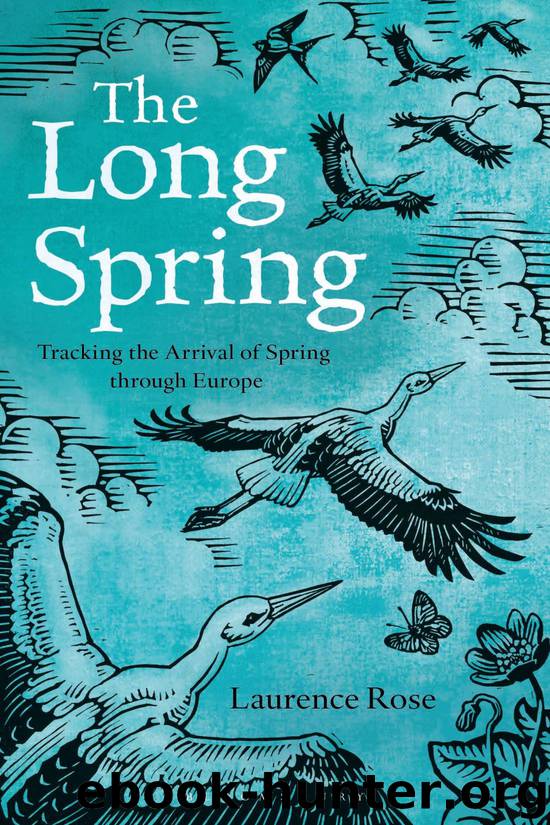The Long Spring by Laurence Rose

Author:Laurence Rose
Language: eng
Format: epub
Publisher: Bloomsbury Publishing
Swallows have been here as long as we have, and without doubt for as long as the barns behind us have, some 350 years. In our first spring, a swallow arrived on 7 April. It was a typical appearance: a male circled low around The Hamlet, repeatedly quartering the few yards that separate the back of our house from our neighbour’s barns. Nearly three weeks later, I bumped into another neighbour. He was outside, looking up at the sky.
‘Twenty-sixth of April,’ he said, ‘swallows should be here.’
‘Yes,’ I said, ‘the first one arrived on the seventh. Look – there’s one.’
‘Well that’s odd, they are supposed to arrive on the twenty-sixth.’
Since then, swallows have arrived here on dates ranging from 3 to 15 April. In every year, from the day the first bird has arrived, there have been swallows every day until the end of the summer. This year has been the only exception. On 4 April, I saw two from an upstairs window. The following day and each day until I returned to France on the 7th, I looked for them in vain. Each evening on the phone Jane would report news from The Hamlet, and the continued absence of swallows. They may have arrived after I crossed the Channel into England and Jane came south to meet me, when neither of us was here to witness it. We arrived home on the 15th, late in the evening, and saw a pair the next day.
I have noticed that the first bird back is always a male, or a male with someone I presume to be his mate; never a lone female. Unpaired males arrive back on their breeding grounds first, singing as they come, to find suitable habitat, familiarise themselves with the lie of the land and wait for an unattached female to turn up. Established pairs arrive together. Ringing studies have shown that as long as both partners survive, they remain faithful to each other (it would be better to say they remain together, despite regular infidelity) for life, and generally faithful to their home ground. Unknown until recently was whether they stay together during their long migrations and on their wintering grounds. In July 2012 a pair were fitted with geolocator tags12 at their breeding site in northern Spain. Both left the area on the same day, 9 September, and arrived in the same wintering area in West Africa on 20 September. The return northward journey also started on the same day, 20 March, and both individuals were back at their Spanish breeding site on 10 April. Throughout the winter, wherever they went, they remained together.13
25 April, Loch Kinord, Aberdeenshire. 57° 05’ N. The first willow warbler arrived here on 19 April, the noticeboard in the visitor centre says, and there are four or five singing in the woods at the edge of the loch. Its simple, down-the-scale whistle is the confirmation I listen for that spring has arrived, and I am pleased to hear a little community of them at last.
Download
This site does not store any files on its server. We only index and link to content provided by other sites. Please contact the content providers to delete copyright contents if any and email us, we'll remove relevant links or contents immediately.
The Lonely City by Olivia Laing(4774)
Animal Frequency by Melissa Alvarez(4431)
All Creatures Great and Small by James Herriot(4277)
Walking by Henry David Thoreau(3926)
Exit West by Mohsin Hamid(3797)
Origin Story: A Big History of Everything by David Christian(3666)
COSMOS by Carl Sagan(3593)
How to Read Water: Clues and Patterns from Puddles to the Sea (Natural Navigation) by Tristan Gooley(3434)
Hedgerow by John Wright(3322)
How to Read Nature by Tristan Gooley(3295)
The Inner Life of Animals by Peter Wohlleben(3286)
How to Do Nothing by Jenny Odell(3269)
Project Animal Farm: An Accidental Journey into the Secret World of Farming and the Truth About Our Food by Sonia Faruqi(3194)
Origin Story by David Christian(3170)
Water by Ian Miller(3159)
A Forest Journey by John Perlin(3045)
The Plant Messiah by Carlos Magdalena(2903)
A Wilder Time by William E. Glassley(2838)
Forests: A Very Short Introduction by Jaboury Ghazoul(2815)
